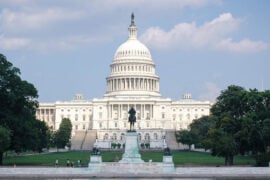University of Toronto philosophy professor Joseph Heath argues for a reinstatement of rationality in social and political discourse in his new book, Enlightenment 2.0.[1] This book provides modern examples of statements by politicians that are not based on proper factual or logical foundations. We could use some rational logic in the world of administrative monetary penalties. The new Canadian Anti Spam Law, (CASL)[2] is enforced by a maximum administrative penalty (AMP) of $1,000,000 in the case of an individual, and $10,000,000 in the case of any other person. AMPs defy logic in two significant ways. First, CASL states explicitly under the heading of “Administrative Monetary Penalties”, “Violations” and the “purpose of penalty” that “the purpose of a penalty is to promote compliance with this Act and not to punish.”[3] The proposition that penalties do not punish not only defies logic but also violates basic rule of the English language. Penalty is defined as “A punishment imposed for breaking a law, rule, or contract.[4] Secondly, the scheme defies logic by setting the amount of the penalty before submissions are made on the threshold issue of liability for the alleged violation. This note submits that there is a way to resolve the logical paradox of penalties that do not punish, based on the distinction between “prices” as contrasted to “sanctions”. This conceptual distinction was articulated over 20 years ago by Robert Cooter in his article “Prices and Sanctions”[5]
(A) REPUTATIONAL DAMAGE CAUSED BY A NOTICE OF VIOLATION
A recent example under CASL is the issuance by the Canadian Radio-television and Telecommunications Commission’s (CRTC) of a notice of violation to Compu-Finder on March 5, 2015 assessing the penalty to be $1.1 million. The e-mails sent by Compu-Finder promoted training courses to businesses.[6] The assessment of a $1.1 million penalty “front loads” the scheme by putting the penalty cart before the liability horse. CASL does provide a mechanism to contest the Notice of Violation, which shall “inform the person that they may make representations to the Commission within 30 days after the day on which the notice is served or any longer period set out in the notice, and set out the manner for making the representations.”[7] The front loading of the penalty (before liability is confirmed by the Commission) creates the possibility of reputational damage being caused to an entity that is “not guilty” of the violation. In a statement, Manon Bombardier, chief compliance and enforcement officer with the CRTC said Compu-Finder “ . . . flagrantly violated the basic principles of the law by continuing to send unsolicited commercial electronic messages after the law came into force to e-mail addresses it found by scouring web sites. Complaints submitted to the Spam Reporting Centre clearly indicate that consumers didn’t find Compu-Finder’s offerings relevant to them. By issuing this Notice of Violation, my goal is to encourage a change of behaviour on the part of Compu-Finder such that it adapts its business practices to the modern reality of electronic commerce and the requirements of the anti-spam law.”[8] I am not being critical of Ms. Bombardier for making this statement, as this is clearly her mandate, but rather my comment is directed at the structure of AMPs themselves, which put the penalty cart before the liability horse. The headline of one media story following this case declared “Quebec company hit with $1.1 penalty under CASL.[9] I am not faulting the author of the story who properly pointed out that “Compu-Finder has 30 days to submit written representation to the CRTC, or pay the penalty. It also has the option of requesting an undertaking with the CRTC — a form of settlement under the legislation to which the CRTC would have to agree.”[10] What I do take issue with is the mechanism in CASL of setting the magnitude of the penalty in advance of the making of representations. AMPs defy logic by assessing a penalty before there is a finding of liability. Suppose for the sake of argument that Compu-Finder has a valid due diligence defence. A person must not be found to be liable for a violation if they establish that they exercised due diligence to prevent the commission of the violation.[11] If a person makes representations in accordance with the notice, the Commission must decide, on a balance of probabilities, whether the person committed the violation and if there is a valid due diligence defence established by the entity, the Commission will find that no violation has been committed.[12] For the sake of argument, if Compu-Finder had a valid due diligence defence resulting in a finding that they did not violate CASL, the reputational damage arising from headlines referring to million dollar penalties is hard to undo, if not impossible. Moreover, in light of the CASL legislation that permits penalties to be assessed prior to liability, a company that is exonerated would have no legal recourse to recover damages caused to its business reputation. Imagine if this were the process in regulatory offence procedure whereby the prosecutor announced that a company was charged with violating occupational health and safety law and in the same breath stated that the fine would be $1.1 millions. For a more extreme example, imagine a prosecutor stating to the media before a trial commenced that the sentence for a person charged with fraud should be seven years in the penitentiary. Such conduct would violate the presumption of innocence. Therein lies a key distinction. Administrative monetary penalties are not offences and do not attract Charter protection. Many cases confirm that large penalties, indeed very large penalties, can qualify as administrative monetary penalties governed by administrative law principles, free from the requirements of s. 11 of the Charter: United States Steel Corporation v. Canada (Attorney General;[13] Rowan v. Ontario Securities Commission; [14] Lavallee v. Alberta (Securities Commission);[15] and R. v. Guindon.[16] The Guindon case was heard by the Supreme Court of Canada concerning a constitutional challenge to the AMPs scheme in the Income Tax Act. The case was heard in December of 2014 and judgment is under reserve.
(B) PENALTIES THAT DO NOT PUNISH; PRICES VERSUS SANCTIONS
As noted earlier, CASL states explicitly that “the purpose of a penalty is to promote compliance with this Act and not to punish.”[17] The legislated concept that penalties are not meant to punish violates rationality on many different levels. First, it violates the English language. The CASL legislation operates in a parallel universe where penalties do not punish. This is truly a bizarro world where everything that you thought was the case, in fact is the reverse.[18] It is the equivalent of a legislature defining the addition of 2 plus 2 to be 5 and not 4. The problem with the legislative intervention in English rules or mathematical rules is that it throws into doubt all of the other English and mathematical rules. On a second level, the concept that penalties are not meant to punish undermines the very concept of deterrence that the legislature intended. If the penalties do not punish, how can they deter conduct? If penalties do not punish, is there not a danger that they become a mere licence fee to do business? This note submits that there is a way to resolve the logical paradox of penalties that do not punish, based on the distinction between “prices” as contrasted to “sanctions”. This conceptual distinction was articulated over 20 years ago by Robert Cooter in his article “Prices and Sanctions.”[19] Cooter suggests a “simple” test for deciding whether a law creates a sanction or a price: “Sanctions increase with the need for deterrence, as indicated by the actor’s state of mind, whereas prices increase with the amount of external harm caused by the act, which is invariant with respect to the actor’s state of mind.”[20] Cooter provides an example to illustrate the difference in these concepts. A parking ticket does not increase with subsequent infractions. One could choose to park every day on the street and pay the ticket, rather than parking in a private lot. Parking tickets are “prices”.[21] By way of contrast, drunken driving is enforced by “sanctions” that increase with subsequent violations. As a society we condemn drunken driving because of the potential that it may kill people, and there is a strong need for deterrence based on escalating penalties including mandatory jail sentences for subsequent offences AMPs could be rationalized as being “prices” rather than “sanctions”. In this respect, AMPs play a proper role at the lower level of the enforcement pyramid, which can be escalated to the regulatory offence or criminal model where sanctions apply. If this model were adopted, there would be a hard dividing line between AMPs and regulatory and criminal offences, which would not require the twisting of the English language. We need to return to a system that adheres to both linguistic and mathematical rules.[22] Logic dictates that we should accept no less. * This article was first published in the Toronto Law Journal and has been re-published with the approval of the Journal. [1] Joseph Heath, Enlightenment 2.0: Restoring Sanity To Our Politics, Our Economy, and Our Lives, HarperCollins Publishers. See the review by Benjamin Leszcz, National Post April 25, 2014, http://news.nationalpost.com/arts/books/book-reviews/enlightenment-2-0-by-joseph-heath-review [2] An Act to promote the efficiency and adaptability of the Canadian economy by regulating certain activities that discourage reliance on electronic means of carrying out commercial activities, and to amend the Canadian Radio- television and Telecommunications Commission Act, the Competition Act, the Personal Information Protection and Electronic Documents Act and the Telecommunications Act, S.C. 2010, c. 23, Assented to 2010-12-15 (CASL). [3] CASL section 20 (2). [4] http://www.oxforddictionaries.com/definition/english/penalty [5] Robert Cooter, “Prices and Sanctions” (1984), 84 Col. Law Rev. 1523. [6] CRTC Notice of Violation, http://www.crtc.gc.ca/eng/archive/2015/vt150305.htm [7] CASL section 22(2) (d). [8] Jennifer Brown, “Quebec company hit with $1.1-million penalty under CASL” , March 9, 2015, In House, Canadian Lawyer Magazine, http://www.canadianlawyermag.com/5499/Quebec-company-hit-with-$1.1-million-penalty- under-CASL.html?utm_source=responsys&utm_medium=email&utm_campaign=CLNewswire_20150309 [9] Jennifer Brown, supra [10] Jennifer Brown, supra [11] CASL section 33. [12] CASL section 25. [13] United States Steel Corporation v. Canada (Attorney General); 2011 FCA 176. [14] Rowan v. Ontario Securities Commission, 2012 ONCA 208. [15] Lavallee v. Alberta (Securities Commission), 2010 ABCA [16] R. v. Guindon, [2013] 5 C.T.C. 1, 2013 FCA 153. [17] CASL, section 20(2). [18] Seinfeld: Season 8, Episode 3; The Bizarro Jerry (3 Oct. 1996) Elaine meets Kevin’s friends and feels likes she’s entered the world of Bizarro Jerry where her world is in reverse. [19] Robert Cooter, “Prices and Sanctions” (1984), 84 Col. Law Rev. 1523. [20] Ibid., at pp. 1537-38. [21] Ibid., at p. 1551. [22] For a proposed pyramid model of AMPs, see Archibald, Jull and Roach, Regulatory and Corporate Liability: From Due Diligence to Risk Management (Canada Law Book, 2014 updated annually).



